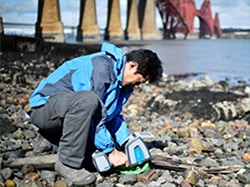Determining the Health Risks of Microplastics
The world produces about 400 million metric tons of plastic a year, and there's now concern that microplastics – the small particles created by the degradation of plastic used in cosmetics, personal care products, children 's toys and household goods -- are contaminating our waterways, soil, air, food and drinking water. While microplastics are defined by National Oceanic and Atmospheric Administration as particles less than 5 mm, the smaller particles between 10-300 um are often of most interest.
The implications for human health are currently unknown, and little is known about how microplastics affect the human body along with their ability to absorb other environmental contaminants in humans and wildlife. Agilent is working with researchers to develop standards for measuring microplastics particles.
The World Health Organization (WHO) is calling for further assessment of microplastics in the environment and their potential impacts on human health, following the release of an analysis of current research related to microplastics in drinking water.
"We urgently need to know more about the health impact of microplastics because they are everywhere -- including in our drinking water," says Dr Maria Neira, Director of the Department of Public Health, Environment and Social Determinants of Health, at WHO. "Based on the limited information we have, microplastics in drinking water don't appear to pose a health risk at current levels. But we need to find out more. We also need to stop the rise in plastic pollution worldwide."
Further research is needed to gain a more accurate assessment of exposure to microplastics and their potential impacts on human health, according to the WHO. These include developing standard methods for measuring microplastic particles and their characterization in water; more studies on the sources and occurrence of microplastics in fresh water; and the efficacy of different treatment processes.
|
Regulators and industry are now funding studies to determine the risks that microplastics pose to the environment, food chain and, ultimately, human health. Agilent is part of a coalition of organizations and researchers working to develop standard operating protocols for quantifying and characterizing microplastics in terms of chemical identity, size, shape, and total mass. Agilent's expertise in infrared (IR) imaging provides an ideal tool to measure microplastics. IR imaging provides the opportunity to simultaneously identify the shape, size, type and characterization of microplastics -- something that is lacking in many other analytical techniques. In addition, Agilent offers both benchtop and portable handheld solutions to analyze microplastics onsite in the environment enabling immediate and real-time information. |
A research group led by Jes Vollertsen , a professor in the Department of Civil Engineering at Aalborg University is using Agilent's IR solutions to monitor microplastics in the environment. These research efforts have been highlighted in a Chemical & Engineering article on "The Pervasiveness of Microplastics".
Agilent has also released the 8700 Laser Direct Infra-red (LDIR) imaging system that is geared to analyzing microplastics faster and more reliably than traditional FT-IR systems. Critically, the LDIR software fully automates the identification and analysis of microplastics that saves users time and increases reproducibility.
 Professor Jes Vollersten, Department of Civil Engineering, Aalborg University, Denmark discusses his team’s research toward Analyzing the Urban Environment and Safety in the Lab
Professor Jes Vollersten, Department of Civil Engineering, Aalborg University, Denmark discusses his team’s research toward Analyzing the Urban Environment and Safety in the LabView video
Mass spectrometry is another technique to learn about the mass-fraction and composition of specific plastic constituents and polymers; though it does not reveal the number, surface area and other characteristics of microplastics. Typically, a thermal extraction or pyrolysis technique is used with a gas chromatograph coupled to a single quadrupole mass spectrometer (GC/MSD) for this work.
Agilent is also working with researchers to analyze and identify specific constituents (phthalates) added to plastics that can be toxic at extremely low concentrations in the environment. Dr. Fiona Regan, director of the DCU Water Institute at Dublin City University in Ireland, is looking at ng/L levels of phthalates in water using LC-MS/MS.
As plastics continue to enter the environment, understanding their global impact is vital to addressing microplastic pollution. Agilent is collaborating with researchers and global organizations toward creating standardized analytical solutions to reliably identify microplastic pollution and develop strategies to ensure a safe environment.Resources:
- Data Integrity Resource Center
- Does Your Electronic Data System Meet 21 CFR Part 11 and CGMP Requirements?
- Agilent OpenLab Software Suite

